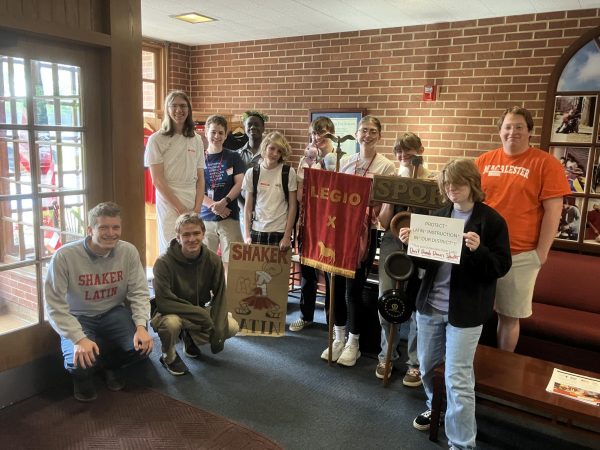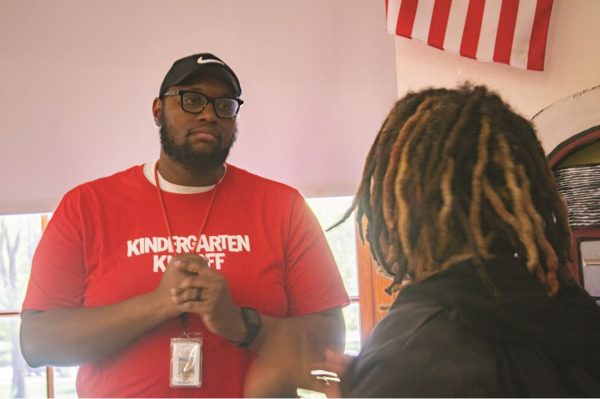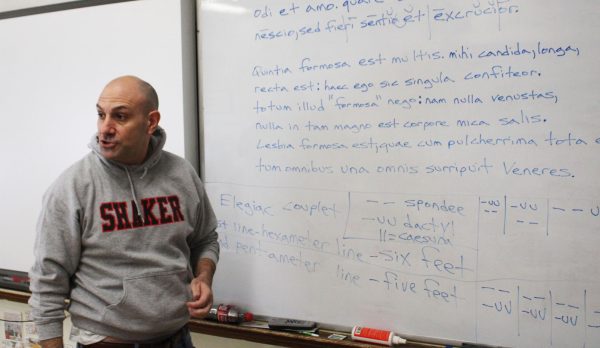Changing Requirements, Tight Schedules Challenge Shaker’s Elective Enrollment
More classes with fewer than 15 students enrolled may be in question after next year
How much lower can elective enrollment go?
That was the question school officials asked when they sat down to look into the high school’s diverse elective coursesand their enrollments. Class sizes in electives vary, with many having fewer than 10 students.
“What we’re doing is we’re making sure that we don’t have any classes with five kids in them. Superintendent Gregory C. Hutchings, Jr. said. “So this year, when we were going through the course selection process, I wanted to sit in and see if there were many classes with five of six kids in them.” Hutchings wanted to audit the schedule after community members told him several five-person classes existed at the high school.
In the 2013-2014 school year, a variety of electives were offered throughout the curriculum. These classes range from the Gristmill to Film as Art. Those courses had enrollment of seven and 14 respectively.
While no classes were cut for this upcoming school year, sections were combined as a result of decreased enrollment. Hutchings explained that if electives did not have adequate enrollment, they could be cut in the future. The Oppression class, taught by long-standing teacher Terrence Pollack for the last 30 years, was not offered this year due to lack of enrollment.
“My biggest concern was that I didn’t want to have a number of classes with less than 15 students in operation,” Hutchings said.
The majority of Shaker classes under the 15-student mark currently are team-taught, core classes such as English and social studies, but the list also includes Creative Writing, Photography II, Journalism, Film as Art, Weight Training, Oceanography and Sociology.
“We want to give students options, but we also want to make sure that there’s enough kids that there can be conversation and collaboration,” Hutchings said.
“Generally we try to run classes at 15 as a low. It depends on the course in question,” Principal Michael Griffith said. “There are some classes that by design we run small, like IB classes or team classes.”
In a review of research conducted on class sizes, the National Education Policy Center stressed the importance of class size. The review states that “all else being equal, increasing class sizes will harm student outcomes.”
Smaller classes may be more effective, but if they shrink too much, low enrollment could remove them from the curriculum.
Elective enrollment at the high school could be decreasing due to many factors. In some cases, even when students earn A’s in electives, the grade reduces the student’s GPAs because it typically carries a lesser weight. While classes such as AP Music Theory are 5.0 credit, Photography, Graphics and Theatre Management, among others, are offered for 4.0 credit.
“I think students do worry about the weight,” guidance counselor Catherine Szendrey said. However, “it’s not the right thing to worry about because colleges recalculate them anyway.” Many colleges recalculate GPAs to enable comparison of students from different schools, as schools weight their course offerings differently.
Students may also feel constrained by heavy course loads. “People are very busy and have a lot to do, especially students in AP classes,” sophomore Cliff Seeger-Destino said. “And students in AP classes are the ones more likely to take particular electives.”
“I think that people take the classes they think they need for college rather than the classes they want to take,” Seeger-Destino said. “Like you might really want to take Photography or something, but you feel like that won’t be as good as AP classes.”
“There’s such an incredible pressure on students to take that extra class in core subjects,” said Theatre Arts Department Chairmen Scott Sumerak, who teaches theater electives. “A lot of that external pressure is squeezing those electives out.” He said there are so many programs at Shaker and in education in general today that students often don’t have time to take electives.
Sumerak’s smallest elective is Theater Management, with about 12 students this year. “It’s a very unique, specialized class that doesn’t really work well in a large group,” he said.
The allure of study halls also drags students away from electives, according to sophomore Maggie Cullina. “I could take an elective but my study hall is really nice,” she said. “I’m in a sport and I get a lot of my homework done during school.”
Other factors could include increasing pressure from mandatory state guidelines. “The state requirements have gone up,” Szendrey said. “I think that’s driving the boat on this.”
“There’s certainly been more and more focus on state requirements,” Griffith said. The state minimum for graduation through 2013 included a requirement for six elective credits, including foreign language. This number was cut to five in 2014. Other changes include an increase in mathematics unit requirements from three to four.
The Shaker 2014-15 Course Catalog & Program Planning guide states that Shaker requires four elective credits for students to graduate, not including world language or fine arts requirements.
“What we’re looking at for the future is to have pathways for students to go into particular courses,” Hutchings said. “For instance, if we have a class with 16 people in it, we may need to begin to have a pathway to have more students prepared, or we need to go out and recruit.
Hutchings said that a pathway would consist of a related course that would lead into an elective and could start as early as middle school. “A pathway is just trying to peak interest sooner than later, ” he said.
Hutchings emphasized finances were not a factor in the push to increase class sizes. “It’s really about our kids,” Hutchings said. “Money can be a factor for anything, but our main priority is to provide every student with a quality education.”
Hutchings’ contract specifies potential bonuses of up to $25,000 each year based on completion of five “performance goals,” including “student achievement,” “performance,” “fiscal responsibility” and “personnel management.”
Hutchings also indicated online class opportunities were an objective for the near future. “The goal is to offer more online options so that [counselors] can fit certain classes in students’ schedules,” Hutchings said. “In the 2015-2016 school year, we will be expanding online options.”
Szendrey advised students not to shy away from electives. “At the end of the day, colleges don’t want a robot,” she said. “They want students who have tried things and found their passions.”





